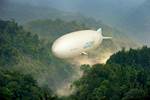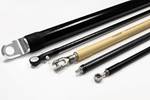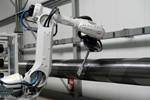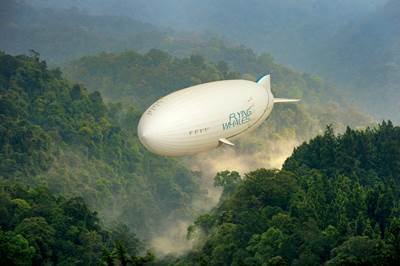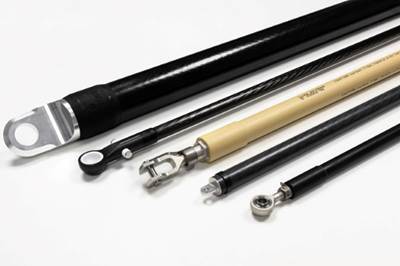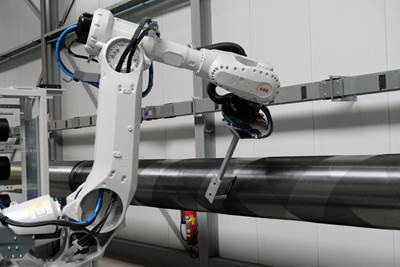
Epsilon Composite’s Blacklite stretcher features a foldable carbon fiber/epoxy frame to combine light weight, portability and rigidity. Source (All Images) | Epsilon Composite
Emergency medical stretchers, particularly those used by the military, require a difficult-to-achieve set of parameters: they must be lightweight and foldable so as to be easily carried in a backpack, durable enough to survive rough handling and potentially harsh environments, but also strong and rigid enough to carry a patient securely.
Carbon fiber pultrusion and pull-winding specialist Epsilon Composite (Gaillan en Médoc, France), which manufactures parts ranging from aircraft struts to utility conductor cores and more, set out to working on a carbon fiber composite stretcher design that achieved each of those parameters.
According to Alexandre Lull, deputy CEO of Epsilon Composite, the original idea came from former military special forces members, who explained the need for a better lightweight stretcher design. Other existing options made from aluminum or carbon fiber composites are either relatively heavy, bulky or too flexible to enable both easy transport and secure transfer of a wounded person, Lull says.
Over the next 2 years, the Epsilon team developed and patented what is now called its Blacklite retractable stretcher. Essentially, the design comprises two parallel poles made up of a series of telescopic tubes, one mounted inside the other, a flexible fabric suspended between the poles and a two-part transverse stiffener in the middle for added rigidity.
The parallel poles are each composed of eight carbon fiber/epoxy telescopic tubes manufactured via pull-winding — a variation on pultrusion that involves winding of dry fibers around the mandrel before entering the die, enabling precise, multidirectional fiber orientation. The ends of each tube are fitted into and bonded to metallic rings that serve as an attachment point for the fabric of the stretcher and as additional reinforcement to prevent cracking or other damage. A separate carbon fiber/epoxy stiffener is made via pultrusion, enabling 100% unidirectional fibers. This stiffener is attached transversely across the fabric stretcher to add rigidity and stability for the patient and carriers. 
Designed based on feedback from French special forces, the stretcher features robust, easily foldable parallel poles and a transverse stiffener for extra support.
To store the stretcher, the stiffener rods are removed, and the rest of the frame and attached fabric are folded in half — via an aluminum hinge connecting the middle two tube segments on each parallel pole — and then the telescopic tubes slide together into a compact shape that fits in a small carrying bag.
In 2019, French special forces units began testing Epsilon’s prototype stretchers, first in training, then in the field. Based on feedback from this testing, Epsilon adjusted and improved the design several times over the following years. For example, Lull notes that extra abrasion protection was added in areas of the stretcher that saw impact on rocky terrain. Assembly tolerances were also tightened to ensure the tube connections remained stable, even if the stretcher was unfolded roughly in an emergency situation. The textile parts of the stretcher were also redesigned to improve ergonomics.
The final, commercial design is “roughly the size and weight of a large water bottle,” Lull says, weighing less than 2.5 kilograms and measuring 40 × 10 × 10 centimeters, though rated to carry up to 200 kilograms. “This carbon fiber stretcher provides the features of a rigid stretcher, which is essential to keep wounded persons stable, while only requiring two people to carry it,” he says.
The commercial product was launched in March 2023 at the Special Operations Forces Innovation Network Seminar (SOFINS) in Bordeaux, France. “Since then, we’ve entered into serial production and delivered Blacklite stretchers to various units in France and globally,” Lull says.
Epsilon hopes to expand the product into more regions, including looking for a distribution partner in the U.S., and applications, with potential uses both in military and in emergency rescue operations.
Related Content
The lessons behind OceanGate
Carbon fiber composites faced much criticism in the wake of the OceanGate submersible accident. CW’s publisher Jeff Sloan explains that it’s not that simple.
Read MoreSulapac introduces Sulapac Flow 1.7 to replace PLA, ABS and PP in FDM, FGF
Available as filament and granules for extrusion, new wood composite matches properties yet is compostable, eliminates microplastics and reduces carbon footprint.
Read MoreCryo-compressed hydrogen, the best solution for storage and refueling stations?
Cryomotive’s CRYOGAS solution claims the highest storage density, lowest refueling cost and widest operating range without H2 losses while using one-fifth the carbon fiber required in compressed gas tanks.
Read MoreTU Munich develops cuboidal conformable tanks using carbon fiber composites for increased hydrogen storage
Flat tank enabling standard platform for BEV and FCEV uses thermoplastic and thermoset composites, overwrapped skeleton design in pursuit of 25% more H2 storage.
Read MoreRead Next
Exel pull-wound composites to enable Flying Whales airship design
State-of-the-art VTOL rigid airship, to take 80 kilometers of thin-wall carbon fiber tubes, will function like an airborne crane for transporting cargo in remote areas.
Read MoreNovel processes for hybrid thermoset-thermoplastic pultruded parts
CFRP pultrusion and pullwinding specialist Epsilon Composite combines thermoplastic overmolding with traditional thermoset processes, demonstrated through aircraft struts and industrial applications.
Read MoreOptimizing robotic winding of composite tanks and pipes
Pioneer in mandrel-based reinforced rubber and composite products, TANIQ offers TaniqWindPro software and robotic winding expertise for composite pressure vessels and more.
Read More

.jpg;width=70;height=70;mode=crop)
